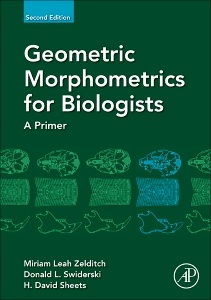Geometric Morphometrics for Biologists (2nd Ed.) A Primer
Auteurs : Zelditch Miriam, Swiderski Donald, Sheets H. David

The first edition of Geometric Morphometrics for Biologists has been the primary resource for teaching modern geometric methods of shape analysis to biologists who have a stronger background in biology than in multivariate statistics and matrix algebra. These geometric methods are appealing to biologists who approach the study of shape from a variety of perspectives, from clinical to evolutionary, because they incorporate the geometry of organisms throughout the data analysis. The second edition of this book retains the emphasis on accessible explanations, and the copious illustrations and examples of the first, updating the treatment of both theory and practice. The second edition represents the current state-of-the-art and adds new examples and summarizes recent literature, as well as provides an overview of new software and step-by-step guidance through details of carrying out the analyses.
1. Introduction
Part I: Basics of Shape Data2. Landmarks and Semilandmarks3. Simple Size and Shape Variables: Shape Coordinates4. Theory of Shape5. The Thin-plate Spline
Part 2: Analyzing Shape Variables6. Ordination Methods7. Partial Least Squares8. Statistics9. General Linear Models
Part 3: Applications10. Evolutionary Developmental Biology11. Variational Properties12. Ecological and Evolutionary Morphology13. Systematics14. Forensics
Dr. Miriam Zelditch is Associate Research Scientist at the University of Michigan’s Museum of Paleontology. She obtained her PhD in Zoology from Michigan State University and conducted her NSF Postdoctoral Fellowship at the University of Michigan. Her research interests broadly include zoology, paleobiology, evolutionary biology, comparative biology, and morphology. She has co-edited both prior editions of Geometric Morphometrics for Biologists.
Dr. Donald Swiderski is Adjunct Assistant Research Scientist at the University of Michigan’s Museum of Zoology. He obtained his MSc in Paleontology and his PhD in Zoology from Michigan State University. His research interests broadly include zoology, paleontology, comparative vertebrate anatomy, mammalogy, and morphology. He has co-edited both prior editions of Geometric Morphometrics for Biologists.
- Contains updated coverage of methods, especially for sampling complex curves and 3D forms and a new chapter on applications of geometric morphometrics to forensics
- Offers a reorganization of chapters to streamline learning basic concepts
- Presents detailed instructions for conducting analyses with freely available, easy to use software
- Provides numerous illustrations, including graphical presentations of important theoretical concepts and demonstrations of alternative approaches to presenting results
Date de parution : 09-2012
Ouvrage de 488 p.
19x23.3 cm
Disponible chez l'éditeur (délai d'approvisionnement : 14 jours).
Prix indicatif 77,27 €
Ajouter au panierThème de Geometric Morphometrics for Biologists :
Mots-clés :
affine components; allometric repatterning; balanced designs; bending-energy; between-groups PCA; bitemark analysis; Bookstein shape coordinates; canalization; canonical variates analysis; centering; centroid size; character delineation; character transformation; classification; cluster analysis; comparative methods; configuration of points; configuration space; cross-validation; deformation; deformed grids; design matrices; developmental stability; discrimination; disparity; dissociability; eigenvalue; eigenvector; evolutionary morphology; exploratory analysis; fetal alcohol syndrome disorders; forensics; full Procrustes distance; general linear model; geometric morphometrics; Goodall's F; heterochrony; homologous points; Hotelling's T2; human dentition; Kendall's shape space; landmark coordinates; landmarks; mixed models; modularity; morphological integration; multivariate analysis of variance; nearest-neighbor analysis; nested models; non-affine components; non-uniform components; ontogenetic scaling; ontogenetic trajectory; ontogeny; or Procrustes-SP; partial least squares; partial Procrustes distance; partial warps; permutational MANOVA; phenotypic plasticity; phylogenetic analysis; phylogenetic character; pre-shape space; principal components analysis; Procrustes size preserving; Procrustes superimposition; regression; relative warps; repeatability; resistant-fit superimposition; rotation; scale; scaling; semilandmark alignment; semilandmarks; sex estimation; shape; shape analysis; shape and size; shape space; shape variables; singular value decomposition; size; statistical inference; systematics; tangent space; taxonomic discrimination; thin-plate spline; transpositional allometry; two-point registration; unbalanced designs; uniform component; variational properties
